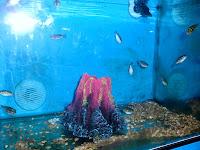 |
| GSP in crowded tanks will glass surf |
Glass surfing, which is the act of swimming up and down the glassin the tank, is a common behavior that green spotted puffers exhibit. It is
frequently noticed in recently purchased puffers, as well as those that are
being kept in improper conditions.
The following are a few of the most common reasons why you
may see your puffer glass surfing:
- You just purchased your puffer. When you first bring home your puffer, their new tank will most likely be stressful to them. After all, they just endured being transported, re-caught, and then placed into a completely foreign environment. As a result, they may end up glass surfing for the first few days until they settle in. You can aid this process by making sure your puffer has plenty of hiding places and plants to help make them feel secure.
- The water quality is deteriorating. Because green spotted puffers eat a very meaty, high protein diet, they also excrete a lot of ammonia back into the water through their waste. To combat this, you must perform weekly water changes to keep their water clean. Often, a puffer that is glass surfing as a result of poor water quality will also have a black belly.
- There isn't enough tank space. Green spotted puffers are very active fish, and they need a large enough tank to not only dilute their waste, but one that also provides enough room for them to explore. They should not be kept in anything smaller than 30 gallons, and they certainly are not suitable fish to keep in a bowl.
- Your puffer is bored. A puffer that does not receive enough stimulation in their tank will quickly become bored. They are very active, curious fish, and as such, require plenty of decorations and plants to break up their line of sight. Aside from adding in more objects to explore, you can also try periodically rearranging some of the decorations to give them something new.
If your green spotted puffer is swimming up and down the
tank for a prolonged period of time, then the first thing you should do is test
the water. If you don't have a water test kit, then you can most likely get
your water tested at a local fish store – many of them offer free/low cost
water testing for customers. However, there is no guarantee that you will be
able to find someone else who is able to test your water for you, which is why
it's very important to obtain your own test kit if you plan on keeping fish for
the long run. I personally use the API Freshwater Master Test Kit because I
like the accuracy that the liquid drop tests offer. That being said, the test
strips work perfectly fine for the casual hobbyist, and they're often cheaper,
as well.
If the water test comes back with an elevated level of
ammonia or nitrite, then you need to perform an immediate water change to
remove some of the toxins. Make sure you add a water conditioner, like Seachem
Prime, before placing any new water in the tank. In the future, try to conduct
your water changes on a regular, weekly basis. All puffers, including green
spotted puffers, are very messy fish, and they require large, frequent water
changes to stay healthy in the home aquaria.
Do you have any questions or comments about glass surfing
puffers? Let me know with a comment!